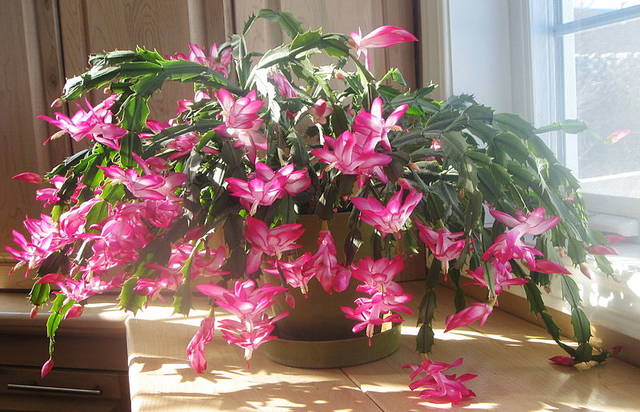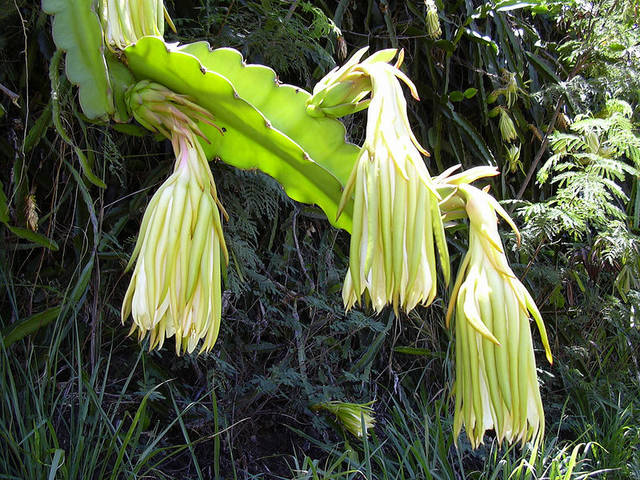Smart gardeners in West Hawaii are installing some drought tolerant plants in their landscapes. Of course, one of the most drought tolerant groups of plants are those that can thrive in the desert. We immediately think of cactus plants.
Although feng shui principles advise against putting prickly or thorny plants near the entrance to your property or home, most landscapes have room for a cactus garden. Cactus plants do well in hot, sunny areas and will grow in marginal and even rocky soil. Though they do need occasional water, they are accustomed to living through long dry spells. Some produce a bonus of lovely flowers and edible fruit. Consider some of these cactus that grow well in Kona to help you start conserving water.
The golden barrel cactus, Echinocactus grusonii, is a well-known cactus species that is native to Mexico. It is rare and endangered in its native Mexican states of Queretaro and Hidalgo but it is popular as a cultivated plant in warm areas around the world where it is grown ornamentally in xeriscape or rock gardens as well as in containers.
Echinocactus grusonii belongs to the small genus Echinocactus. The generic name Echinocactus derives from the Greek echinos, which means spiny and cactus. Members of the genus are usually covered with lots of spines and produce small flowers when mature.
Golden barrels are naturally found growing in volcanic rock on slopes, at upper elevations. They are relatively fast growing in tropical and sub-tropical climates and in Hawaii can do well in most dry areas. They grow best in soil that drains well as wet soil can cause these and many other cacti, to rot.
The knobby appearance of the young barrel cactus develops into about thirty-five pronounced ribs around its spherical shape as it matures. Light colored spines cover the barrel even when the cactus is young. Several varieties with different spine length and colors are available.
The average life span of a barrel cactus is about 30 years. After about 20 years, it will start producing an attractive crown of yellow flowers in early summer followed by a sort of wooly appearing fruit. Some specimens are known to grow over three feet tall.
Several species in the Hylocereus genus of the cactus family produce lovely flowers and delicious fruit. Commonly known as dragon fruit, these plants can be grown as an ornamental plant as well as for their fruit crop. They have an attractive sprawling or vining growth habit and can be either a terrestrial or epiphytic plant. They often appear in gardens as a flowering vine and it can also be grown indoors as a house plant. The vine uses its aerial roots to climb, sometimes reaching a height of 30 feet or more with support of a trellis, ladder, wall or a large plant.
The most popular species in the Hylocereus genus are known by many names including dragon fruit, pitaya, night blooming cereus and belle of the night. The botanical name is a combination of the Greek word hyle meaning woody matter and the Latin cereus which translates to waxen.
In Hawaii, three Hylocereus species are commonly grown. All of them produce fruit with leathery skin and soft spines. Perhaps the favorite, Hylocereus undatus, or white-fleshed pitaya, has red skin and white flesh. Hylocereus costaricensis, or red-fleshed pitaya, produces a red-skinned fruit with red flesh. Hylocereus megalanthus, or yellow pitaya, has yellow-skinned fruit with white flesh. Many find this variety to be the sweetest.
All members of the genus Hylocereus have fleshy, waxy green stems that are usually three-sided and segmented with short spines along the wavy edges. The waxy surface reflects harsh sunlight and reduces transpiration to save water. The spines collect dew while protecting the plant from predators. In the absence of leaves, the stems perform the photosynthetic process that provides energy for the plant.
The large, white, fragrant flowers of the dragon fruit bloom at night from nodes along the stem, relying on nocturnal pollinators including moths and bats. Flowers usually wilt by morning. Once pollination occurs, fruit will form at the base of the wilted flower. The fruit can ripen in five to six weeks. Some species will not produce fruit, however, unless hand pollinated. Heathy plants can flower up to six times a year depending on the growing conditions.
This plant is easily grown from cuttings and many local farmers are willing to sell or share a few branches if you ask.
Although you may have seen the prickly pear cactus, Opuntia ficus-indica, growing in lots of the pasture land here on the Big Island in the past, it is mostly gone now. Through the efforts of the Hawaii Ranchers Association, the Hawaii Department of Agriculture brought in the moth Cactoblastis cactorumn whose larvae have eaten about 90 percent of the opuntia cactus that were invading grazing lands. They are no longer sold here and the moth will likely eventually find and kill any that remain.
The Christmas cactus, Schlumbergera truncata, is another member of the large Cactaceae family but with different preferences than many of its desert cousins. Schlumbergera is a small cacti genus of less than 10 species native to the coastal mountains of southeastern Brazil. The plants grow on trees or rocks in shady habitats with high humidity. This species of cactus is more suitable to upper elevations in Kona or planted in a shady container that gets regular watering. Most Schlumbergera species have leaf-like jointed pads for stems and flowers that appear at the joints and tips of the stems. Their name relates to their flowering period. They are also known by the common names Thanksgiving cactus, crab cactus or claw cactus.
Many small cactus family plants stay small and are suitable for containers or to fill small spaces. The hedgehog or sea urchin cactus, Echinopsis spachiana, is an attractive example. Its name derives from the Greek words echinos which translates to either hedgehog or sea urchin, and the ending opsis a reference to the plant’s appearance with a dense covering of spines. This particular species is also known as the Easter lily cactus named for the attractive flowers produced on long tubes that hold them above the stems. The inflorescence is much more attractive than one might expect from these small cacti.
Among the 128 species in the Echinopsis genus are some large treelike types as well as the small globose plants. This large genus of cacti are all native to South America. Echinopsis species are distinguished from the Echinocactus, barrel cactus, based on the length of the flower tube and from the Cereus, dragon fruit, genus by the shape of their stems and the position of the flowers on the stems.
All of these and many more genus and species are available at Pele’s Island Plants in Ocean View. They carry orchids as well as drought tolerant succulents and cacti. Call Bob or Phoenicia Zeller at 333-0889 or go to visit them to see what they have available and what they might recommend for your garden.
Diana Duff is a plant adviser, educator and consultant living in a dryland forest north of Kailua-Kona.
Gardening Events
Saturday: “Work Day at Amy Greenwell Garden” from 9 a.m. to 12:30 p.m. Meet at the Garden Visitor Center across from the Manago Hotel in Captain Cook. Volunteers will be able to help with garden maintenance and are invited to bring a brown bag lunch. Water and snacks provided. Call Peter at 323-3318 for more information.
“Growing from Seed” from 10-11 a.m. at the Kailua-Kona Public Library at 75-138 Hualalai Rd. The Community Seed Library’s Seed Sisters present their experiences planting, growing and harvesting from CSL seeds. Free and open to the public. Come with your gardening questions. For more information call the library at 327-4327.
Farmer Direct Markets
Wednesday: “Ho’oulu Farmers Market” 9 a.m. to 2 p.m. at Sheraton Kona Resort &Spa at Keauhou Bay
“Sunset Farmers Market” 2-6 p.m. in the HPM parking lot at 74-5511 Luhia St. in Kailua-Kona (across from Target)
Saturday: “Keauhou Farmers Market” 8 a.m. to noon at Keauhou Shopping Center
“Kamuela Farmer’s Market” from 7 a.m. to noon at Pukalani Stables
“Waimea Town Market” from 7:30 a.m. to noon at the Parker School in central Waimea
“Waimea Homestead Farmers Market” from 7 a.m. to noon at the Waimea Middle and Elementary School playground
Sunday: “Pure Kona Green Market” 9 a.m. to 2 p.m. at Amy Greenwell Garden in Captain Cook
“Hamakua Harvest” 9 a.m. to 2 p.m. at Highway 19 and Mamane Street in Honokaa
Plant Advice Lines
Anytime: konamg@ctahr.hawaii.edu
Tuesdays and Thursdays: 9 a.m. to noon at UH-CES in Kainaliu – 322-4893
Mondays and Fridays: 9 a.m. to noon at UH CES at Komohana in Hilo 981-5199 or himga@hawaii.edu


